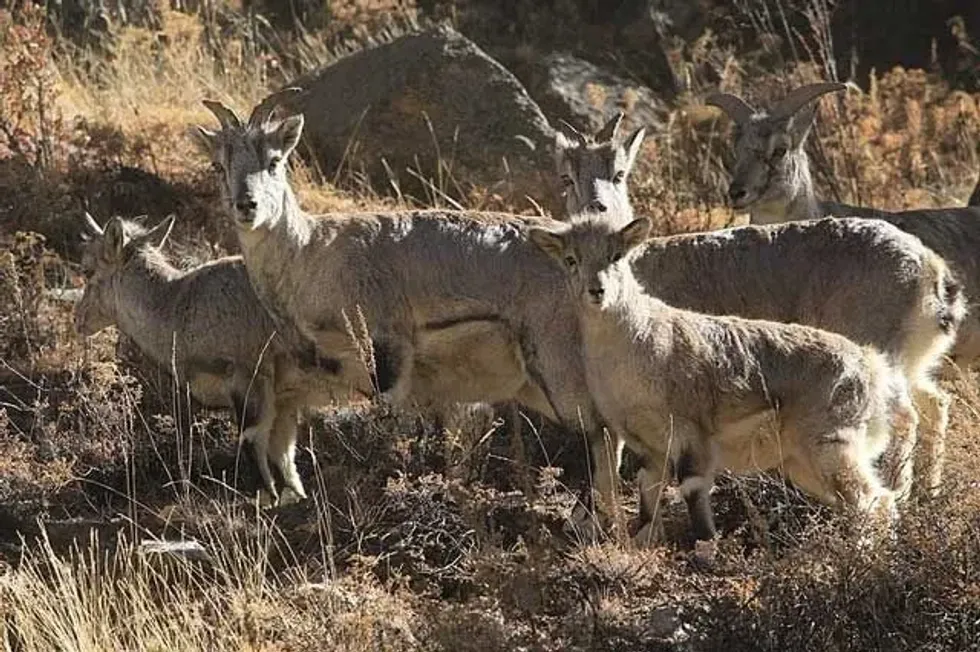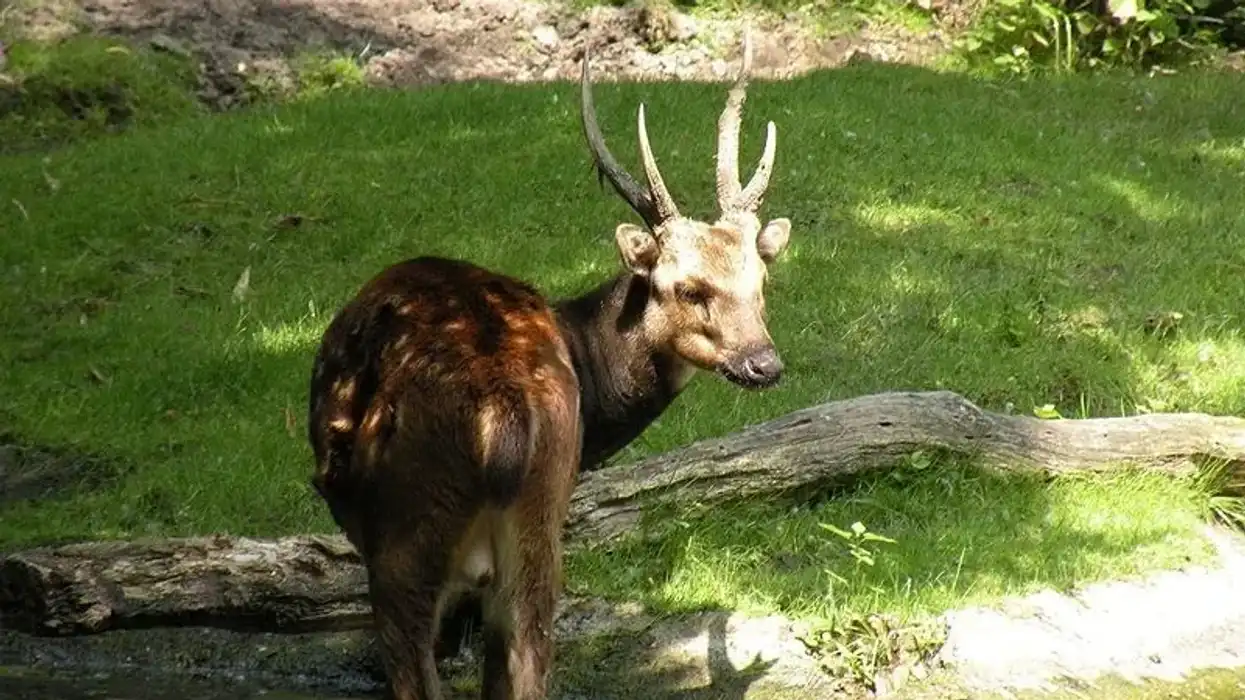The black musk deer, Moschus fuscus is also known as the dusky musk deer, belongs to the family Moschidae.
The range of these black musk deer, Moschus fuscus, includes India, Bhutan, Myanmar, western Yunnan parts of China, and Nepal and south-eastern Tibet, and these musk deer are known to inhabit or found in types of habitat that include forested regions of steep alpines and sub-alpine regions.
This deer is known to be small, and its body is covered with thick brown hair.
It has large and well-developed ears and eyes and possesses no antlers.
The hind legs are comparatively longer than the front ones. The mating or breeding season takes place around late November to December, and the gestation period is about six months long.
The females are known to take care of the young ones for a few months.
The reproduction system is polygynous. The diet of this musk deer is typically herbivorous, and the food includes grasses, lichens, and barks.
It is believed that this musk deer is solitary and does not live with other individuals.
The conservation status of the black musk deer, Moschus fuscus, is Endangered as the population of this species is known to be hunted and poached.
The musk of this deer is known to have various types of importance like known to possess medicinal properties, and its musk is used to make perfumes and thus, has been protected under the international CITES (Convention on International Trade in Endangered Species of Wild Fauna and Flora) pact as its conservation status is Endangered.
It is quite interesting to learn about this musk deer, and if you are interested, read auroch facts and takin facts too.
Black Musk Deer Interesting Facts
What type of animal is a black musk deer?
The black musk deer, or Moschus fuscus, of the family Moschidae, is a deer.
What class of animal does a black musk deer belong to?
Members of the family Moschidae belong to class Mammalia.
How many black musk deers are there in the world?
There is no exact number of the population of these deers recorded or estimated.
Where does a black musk deer live?
Musk deers are mostly found in central and Northeastern Asia or the Asian range. The population of these animals is found in the range that includes India, Bhutan, Myanmar, western Yunnan parts of China, and Nepal, and south-eastern Tibet.
What is a black musk deer's habitat?
These deers, known as Moschus fuscus scientifically, are found in forested regions or forests of steep alpines and sub-alpine regions and even mountains or similar areas. These deers are known to prefer treelines and rocky areas.
Who do black musk deers live with?
These forest musk deer are solitary mammals.
How long does a black musk deer live?
Not much information is available about the lifespan of the Moschus fuscus from the family Moschidae, but it is believed that these deers can live up to 20 years in captivity.
How do they reproduce?
The mating or breeding season of this species of the family Moschidae takes place around late November to December. The reproduction system of these deers is polygynous; that is, males mate with several females.
Scents are released or produced by males to mark their territories. The gestation period of this species is about six months long.
One to two young ones are given birth to, and the mother looks after the newborns for a few months, and the young ones are known to travel with their mothers. The young one reaches or becomes adult-sized at about six months, but sexual maturity is reached at about 18 months.
What is their conservation status?
This species has been assigned or is categorized under the conservation status Endangered.
Black Musk Deer Fun Facts
What do black musk deers look like?

*Please note that this is an image of a Siberian musk deer, a relative of the black musk deer
This species of forest musk deer are known to be small, and males and females are known to be similar in size. The eyes and ears of the dusky musk deer are known to be well developed and large.
Their body is known to be covered with brown and thick hair. The hind legs of this dusky musk deer are thick and long as compared to the front legs.
This dusky musk deer does not have antlers. There exist differences in the base color and markings like spotting. Males are known to have tusk-like canines projecting downwards from the mouth.
The musk gland of this species in males is located between the navel and genitalia, and females are known to possess two mammae. The newborns have spots on their bodies.
How cute are they?
This member of the family Moschidae is not considered cute.
How do they communicate?
This species of musk deer is known to communicate through scents produced by different glands. They also communicate through defecation. The large ears and eyes of this dusky musk deer have been associated with their keen reliability on their senses.
How big is a black musk deer?
These dusky musk deer are known to be smaller than the Indian hog deer. The length of this endangered musk deer ranges from 27-39 in (700-1000 mm).
How fast can a black musk deer run?
The exact speed of this musk deer is unknown, but these musk deer are known to be quite fast.
How much does a black musk deer weigh?
The weight of these deers ranges from 22-33 lb (10-15 kg) and is about three times lighter than the blackbuck.
What are the male and female names of the species?
There are no specific names for a male and female of this endangered species.
What would you call a baby black musk deer?
The baby of this species is commonly referred to as a fawn.
What do they eat?
The food or diet of these dusky musk deers includes grass and lichens. The food also includes leaves, woods, bark, and stems.
Are they dangerous?
Not much information is available about these deers as not much human interaction with these forest musk deers has been observed due to their Endangered status, but they are not considered to be harmful or dangerous to humans.
Would they make a good pet?
Not much information is available about these dusky musk deer as pets, and they are quite uncommon as pets; and in California, it is illegal to own a deer as these are wild animals.
Did you know...
This species of musk deer, Moschus fuscus, is nocturnal and, thus, is most active around night, dusk, and dawn.
These musk deer are known to have the capability to move around the edges of cliffs and thick bushes.
This species of musk deer is most aggressive in its family during fighting with other males.
These musk deers are known to have gallbladders in contrast to other cervids and also are known to not have certain facial muscles or a facial gland.
These musk deers or the species Moschus fuscus are threatened as they are hunted as it is believed that the musk of these deers possess medicinal properties and were traditionally used as stimulants or sedatives. It is also known to have a high demand for perfumes and soap markets.
When in high concentrations, the musk of this musk deer is known to smell like feces.
It is believed that around the 1980s, the worth of the musk of an adult male of the species was around four times its weight in gold.
Predators of the dusky musk deer or wild black deer musk, or Moschus fuscus are lynx and wolverine.
Other species of musk deer include Siberian musk deer, Himalayan musk deer, alpine musk deer, Chinese Forest musk deer, Anhui musk deer, Kashmir musk deer found in North-East Asia, Central Himalayas, Eastern Himalayas, South China, and Northern Vietnam, Eastern China, and Western Himalayas and Hindu Kush range respectively.
Are black musk deers endangered?
The status of the black musk deer is endangered as the population of these deers is a target to poaching and illegal trade.
This species has been protected by the International CITES (Convention on International Trade in Endangered Species of Wild Fauna and Flora) since 1979, but it is believed that not enough is being done to protect this endangered species.
How do you identify a musk deer?
Musk deer is not considered a true deer and is known to differ from the cervidae family. Musk deers are known to have no antlers, and these are also known to have a musk-producing organ and a pod located on the abdomen.
They have long ears and short tails, and males tend to have canine teeth projecting down similar to tusks from the mouth.
Here at Kidadl, we have carefully created lots of interesting family-friendly animal facts for everyone to discover! Learn more about some other mammals from our kudu facts and key deer facts pages.
You can even occupy yourself at home by coloring on one of our free printable siberian musk deer coloring pages.









